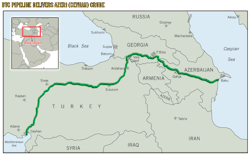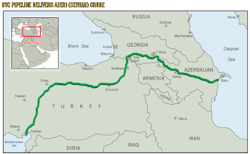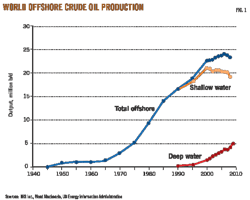Deepak M. Gala, Greg Hawley, Craig Lagrandeur
Weatherford International Ltd.
Houston
Data from wells drilled in 2008 to produce gas from the Canyon sands of the Val Verde basin of West Texas illustrate the effectiveness of hammer bits and underbalanced drilling.
In these wells, underbalanced drilling minimized deviation problems and increased the rate of penetration (ROP) at least three times in comparison with conventional overbalanced drilling.
The membrane-generated nitrogen drilling system provided a safe and economical means of energized-fluid drilling in hydrocarbon producing formations. Also an effective corrosion program counteracted the presence of oxygen in the drilling fluid
To reduce drilling time and costs on high volume, low-pressure wells in West Texas, Weatherford recommends use of oil field hammers or downhole hammers to increase the rate of penetration, minimize deviation problems, and lower rig costs.
For these jobs two suppliers of hammers and hammer bits fulfilled the demand for hammer services.
An important element in any gas-drilling project is knowing when to apply a particular technology such as when deviation during drilling causes problems and the formation is relatively hard and dry. Wells in Sutton County, Tex. met these criteria.
Since early 2008, an independent operator drilled more than 50 wells in Sutton County with downhole hammers and compression equipment. In these wells, the operator without sacrificing ROP minimized deviation problems with downhole hammers and a slick bottomhole assembly.
For vertical wells, the time from spud to TD decreased about 30%, representing a savings of about $25,000/well.
Canyon sand drilling
In the past few years, the Canyon sands have become a major gas play after hydraulic fracturing for independent producers.
Small independents have done most of the past drilling in Sutton, Edwards, and Crockett counties, south of Interstate 10, but now drilling has also moved farther north into Parker and Johnson counties, with future drilling planned in Hood, Hill, and Bosque counties.
Wells drilled for the Canyon sands in Sutton County typically have an average 7,500-9,000 ft TD. Operators usually drill a 121⁄4-in. surface hole to 1,400 ft, set 85⁄8-in. casing, and then drill a 77⁄8-in. hole to TD.
Most wells drilled in the area require only one hammer bit trip for drilling the entire production section.
During January 2008 to August 2008, 20 of the 29 wells studied were drilled in one-trip (Fig. 1). Twenty wells reached TD in a single hammer-bit run, five wells failed to reach TD because of a large amount of influx; three wells had a shank bit and then were completed by rerunning a tricone bit.
Fig. 1 shows depth in and depth out for each hammer-bit run. The longest hammer-bit run was 6,999 ft in 66 hr (106 fph). The shortest run was 650 ft in 9.5 hr (68 fph).
It should be noted that of the nine wells that required additional trips, six wells had a lower cost per foot or were completed in fewer days than wells drilled with conventional drilling techniques.
Fig. 2 shows the combined ROP and footage drilled on each well.
Standard drilling practices with conventional drilling mud in conjunction with roller cone or polycrystalline diamond compact bits produced deviation problems and a slow rate of penetration because of the need to have a high weight on bit (WOB).
Hammer drilling usually resolves most wellbore deviation problems, typically caused by high-formation dip angles, because of lower WOB and rpm requirements.
After setting the 85⁄8-in. casing, the recommended operation is to drill the wells with conventional bits using straight gas or a mist-foam system until deviation problems occur. After that, use hammers and hammer bits to complete the well with straight-air or membrane-generated N2 injection rates of 2,500 cfm.
Mist-foam operations require a surfactant and an additional 15% gas volume to drill the wells. The surfactant helps decrease the gas volume required to 15% rather than the 30% normally needed for efficient mist operations.
Hammer drilling can minimize borehole deviation to less than 4° without sacrificing ROP.
In these wells, a downhole percussion hammer was selected because of its efficiency with a single-phase gas system, as well as its ability to increase ROP and minimize deviation problems.
Should drilling operations encounter significant water influx, one should run a conventional bit in a mist-foam drilling fluid to complete the interval. Typical West Texas operations use air in the top hole section and then use an inert gas (membrane nitrogen) to drill the Canyon sands pay zone, minimizing the possibility of downhole fires.
Hole cleaning, in single-phase gas drilling, depends on velocity rather than rheology. One can determine the maximum ROP based on optimal hole cleaning by using proprietary underbalanced drilling software and injection rates.
Flow modeling during straight air and mist-foam drilling determines the efficient ratios of nitrogen and liquids. Modeling performed during the feasibility study aids in determining the size of surface equipment, the necessary footprint, and provides an initial cost estimate for the project.
The additional cost of the air compressors, high-pressure boosters, and diesel fuel, as well as the hammer, diamond-insert hammer bit, are offset by the mud cost savings, as well as the reduced number of conventional bits, stabilization, or mud motor costs.
Blooie line
Because most wells require converting to a mist-foam system to overcome the predicted water influx, monitoring ensures that the change to mist or foam occurs before a problem develops. It is therefore important in an air drilling to monitor continuously the flow from the blooie line.
The blooie line safely vents the diverted natural gas flow, cuttings, and water from the well (via the wellhead) to the reserve pit assisted by a venturi primary jet system, located towards the end of the blooie line. The venturi create a vacuum at the rotating control device (RCD).
During trips, the wellhead is open to the atmosphere while the RCD maintains a positive seal on the drillstring when making a connection during the drilling operation to divert any gas flow into the blooie line, eliminating reliance on the primary jet.
A typical air drilling rig-up consists of an 8 in., 100-200 ft nominal diameter blooie line fitted with a 1-in. venturi nozzle, sample catchers, deduster, gas detectors, and pilot-light flare igniters.
System components
Air is the base gas for the drilling fluid. The main components of the fluid system are air compressors, pressure boosters, a membrane-generated nitrogen system, and one mist pump.
As engineered for these wells, the equipment delivers 5,000 scfm of air or about 2,500 scfm of membrane-generated N2 and 45 gpm of liquid at 1,500 psi
Most underbalanced drilling jobs use two float valves in the drillstring.
During the hammer operation, the hammer has a dart valve already in place in the top sub, acting as a float valve. The dart valve prevents any flowback, such as water or cuttings, through the hammer.
To expedite pressuring up on the drillstring after connections, one needs to install a flapper-type valve higher up in the drillstring. The top flapper-type valve retains high pressure, membrane-generated N2 within the drillstring, facilitating faster resumption of drilling operations.
One of the primary causes of failure in the hammer is corrosion. To eliminate this, the operations needs to add corrosion inhibitors directly into the gas injection line with a high pressure, low-volume injection pump.
Additionally, the use of a surfactant during mist-foam drilling helps facilitate effective hole cleaning.
The RCD seals the drill pipe and diverts drilling fluid, influx, and cuttings flow into the blooie line to the reserve pit located away from the rig floor.
Typically the wells have a passive, 500-psi RCD for the 77⁄8-in. hole interval.
Used for decades in shallow drilling operations and in water wells, downhole air (or percussion) hammers have gained greater acceptance in drilling deep oil and natural gas wells because of the engineering improvements in the materials in the air hammers and the chemicals needed for extending hammer use in straight air, mist, and foam drilling.
Corrosion inhibitors and better surfactants enable drilling even through a moderate water influx.
Downhole oil field hammers provide a faster ROP and drill straighter holes in the correct applications. When in use, the hammers cycle at 1,600-1,800 beats/min.
Work done by the hammer bit is directly proportional to the energy expended on the piston, the size of the piston, the stroke length, and the number of blows performed.
A choke allows the adjustment of the air volume passing through the hammer for good hole cleaning and optimum pressure across the tool.
Typically the operation will use choke sizes from 1⁄8-in. to 1⁄4-in. (or even blank chokes) to optimize energy transfer to the hammer bit.
The hammer bits need to be lubricated with rock drill oil that is injected continuously into the drill pipe. The correct grade of rock drill oil depends on the temperature and the downhole conditions.
Normally, before beginning the hammer-drilling operation, the inside of the drill pipe needs to be coated with a slug of oil pumped down the drillstring.
The concave face design on the hammer bits have a fully diamond-enhanced protected gauge and face. WOB and rpm are much lower in downhole hammer-drilling operations when compared with conventional drilling operations with conventional drillbits.
The authors
More Oil & Gas Journal Current Issue Articles
More Oil & Gas Journal Archives Issue Articles
View Oil and Gas Articles on PennEnergy.com







